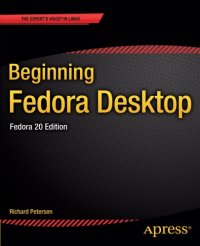
Ebook: Beginning Fedora Desktop: Fedora 28 edition
Author: Petersen Richard
- Tags: Computer programming, Computer programming / software development, Computer science, Computer software, COMPUTERS--Programming--Mobile Devices, Computers--Programming--Open Source, Graphical user interfaces (Computer systems), Open source software, Operating systems (Computers), Electronic books, Linux, COMPUTERS -- Programming -- Mobile Devices, Computers -- Programming -- Open Source
- Year: 2018
- Publisher: Apress
- Language: English
- pdf
Intro; Table of Contents; About the Author; About the Technical Reviewer; Acknowledgments; Introduction; Part I: Getting Started; Chapter 1: Fedora 28 Introduction; Fedora Documentation; Fedora 28; Fedora 28 Features; Fedora ISO Images; Fedora Custom Spins; Multimedia; Fedora Workstation Live ISO; Installing Fedora from a Workstation Live ISO; USB Live Drive; Fedora Media Writer (mediawriter); livecd-iso-to-disk; Live USB Persistence Storage; Persistent Home Directory; Fedora Logo; Linux; Open Source Software; Linux Documentation; Chapter 2: Installation and Upgrade; Obtaining the DVDs;Get the most out of Fedora 28 Desktop, including free Office suites, editors, e-book readers, music and video applications. In addition to those features, you’ll also work with codecs, email clients, web browsers, FTP and BitTorrent clients, VoIP clients, and IM applications. The major Fedora 28 desktop spins are covered in detail, including the Plasma desktop (KDE), Cinnamon, Mate-Compiz, LXDE, Xfce, and LXQT. This is your complete guide to using the Fedora 28 Desktop Linux release as your daily driver for multimedia, productivity, social networking, administrative tasks, and more. Author and Linux expert Richard Petersen delves into the operating system as a whole and offers you a complete treatment of Fedora 28 Desktop configuration and use. With Beginning Fedora Desktop at your side, you’ll discover how to install and update the Fedora 28 Desktop, as well as access various software repositories. You’ll also learn which applications perform which functions, how to manage software, use of the desktop configuration tools, useful shell commands, and both the system administration and network tools. What You'll Learn Review the available desktop choices, including GNOME, KDE, and alternative desktops Administer your system, add users, manage printers and perform backups Configure network connections and firewalls with FirewallD Access network resources with Samba Who This Book Is For Novice to intermediate users who are looking to install Fedora 20 as their primary computing environment.;GNOME Customization with the Tweak Tool: Themes, Fonts, Startup Applications, and ExtensionsLogging Out and Shutting Down GNOME; Network Connections; Network Manager Wired Connections; Network Manager Wireless Connections; Settings WiFi and Network; Settings; Background; Date & Time; Notifications; Privacy; About (System Information); Default Applications; Using Removable Devices and Media; Sharing; Power Management; powertop, tuned, and BLTK; Mouse and Touchpad; Display (Resolution and Rotation); Universal Access; Keyboard and Language; Color Profiles (GNOME Color Manager); Online Accounts;Basic Install of the Fedora WorkstationInitial Setup; Manual Partitioning: Partitions, BTRFS, RAID, and Logical Volumes; Creating Partitions; Logical Volumes; RAID and BTRFS; Advanced Custom (Blivet-GUI); GRUB on Restart; GNOME Initial Setup and GNOME Help; Upgrading Fedora Linux; Creating Boot Disks; Booting in Rescue Mode; Reinstalling the Bootloader; Chapter 3: Usage Basics: Login, Desktop, and Help; GNOME Users; GRUB Start Menu and Boot Problems; The Display Manager: GDM; The System Status Area; Desktops; KDE; GNOME; GNOME File Manager;Accessing File Systems and DevicesVideo Drivers; Multimedia Support: MP3, DVD Video, and DivX; Terminal Window; Command-Line Interface; Running Windows Software on Linux: Wine; Help Resources; GNOME and KDE Help; Application Documentation; The Man Pages; The Info Pages; Web Resources; Shared Network Access for Windows (Samba): Samba; Chapter 4: Installing and Updating Software: DNF, GNOME Software, Packages, DnfDragora, and RPM; Software Repositories; Fedora Software Repositories; RPM Fusion; Adobe and Livna; Third-Party Linux Software Archives;Updating Fedora: GNOME Software and Software UpdateUpdating Fedora with GNOME Software Update; Updating Fedora with Package Updater (PackageKit); Update with the dnf Command; Automatic DNF Updates with dnf-automatic; Installing Software Packages; Managing Software with DNF; GNOME Software (Software); PackageKit (Packages); Managing Repositories; Using the RPM Fusion Repository; DnfDragora; Installing Individual Packages with Your Browser; Installing Some Popular Third-Party Software; Multimedia Packages; Vendor Video Driver Support; Using Repositories; Repository Repo Package Files
Download the book Beginning Fedora Desktop: Fedora 28 edition for free or read online
Continue reading on any device:

Last viewed books
Related books
{related-news}
Comments (0)